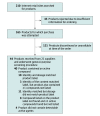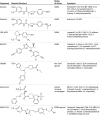Chemical Composition and Labeling of Substances Marketed as Selective Androgen Receptor Modulators and Sold via the Internet
- PMID: 29183075
- PMCID: PMC5820696
- DOI: 10.1001/jama.2017.17069
Chemical Composition and Labeling of Substances Marketed as Selective Androgen Receptor Modulators and Sold via the Internet
Erratum in
-
Omitted Conflict of Interest Disclosures.JAMA. 2018 Feb 20;319(7):724. doi: 10.1001/jama.2018.0613. JAMA. 2018. PMID: 29466569 Free PMC article. No abstract available.
Abstract
Importance: Recent reports have described the increasing use of nonsteroidal selective androgen receptor modulators, which have not been approved by the US Food and Drug Administration (FDA), to enhance appearance and performance. The composition and purity of such products is not known.
Objective: To determine the chemical identity and the amounts of ingredients in dietary supplements and products marketed and sold through the internet as selective androgen receptor modulators and compare the analyzed contents with product labels.
Design and setting: Web-based searches were performed from February 18, 2016, to March 25, 2016, using the Google search engine on the Chrome and Internet Explorer web browsers to identify suppliers selling selective androgen receptor modulators. The products were purchased and the identities of the compounds and their amounts were determined from April to August 2016 using chain-of-custody and World Anti-Doping Association-approved analytical procedures. Analytical findings were compared against the label information.
Exposures: Products marketed and sold as selective androgen receptor modulators.
Main outcomes and measures: Chemical identities and the amount of ingredients in each product marketed and sold as selective androgen receptor modulators.
Results: Among 44 products marketed and sold as selective androgen receptor modulators, only 23 (52%) contained 1 or more selective androgen receptor modulators (Ostarine, LGD-4033, or Andarine). An additional 17 products (39%) contained another unapproved drug, including the growth hormone secretagogue ibutamoren, the peroxisome proliferator-activated receptor-δ agonist GW501516, and the Rev-ErbA agonist SR9009. Of the 44 tested products, no active compound was detected in 4 (9%) and substances not listed on the label were contained in 11 (25%). In only 18 of the 44 products (41%), the amount of active compound in the product matched that listed on the label. The amount of the compounds listed on the label differed substantially from that found by analysis in 26 of 44 products (59%).
Conclusions and relevance: In this limited investigation involving chemical analyses of 44 products marketed as selective androgen receptor modulators and sold via the internet, most products contained unapproved drugs and substances. Only 52% contained selective androgen receptor modulators and many were inaccurately labeled.
Conflict of interest statement
Figures


Comment in
-
The Public Health Consequences of Performance-Enhancing Substances: Who Bears Responsibility?JAMA. 2017 Nov 28;318(20):1983-1984. doi: 10.1001/jama.2017.17111. JAMA. 2017. PMID: 29183050 No abstract available.
Similar articles
-
Doping substances in dietary supplements.Tidsskr Nor Laegeforen. 2019 Feb 25;139(4). doi: 10.4045/tidsskr.18.0502. Print 2019 Feb 26. Tidsskr Nor Laegeforen. 2019. PMID: 30808106 English, Norwegian.
-
Characterization of a non-approved selective androgen receptor modulator drug candidate sold via the Internet and identification of in vitro generated phase-I metabolites for human sports drug testing.Rapid Commun Mass Spectrom. 2015 Jun 15;29(11):991-9. doi: 10.1002/rcm.7189. Rapid Commun Mass Spectrom. 2015. PMID: 26044265
-
Mass spectrometric characterization of urinary metabolites of the selective androgen receptor modulator andarine (S-4) for routine doping control purposes.Rapid Commun Mass Spectrom. 2010 Aug 15;24(15):2245-54. doi: 10.1002/rcm.4637. Rapid Commun Mass Spectrom. 2010. PMID: 20623476
-
Selective androgen receptor modulator use and related adverse events including drug-induced liver injury: Analysis of suspected cases.Eur J Clin Pharmacol. 2024 Feb;80(2):185-202. doi: 10.1007/s00228-023-03592-3. Epub 2023 Dec 7. Eur J Clin Pharmacol. 2024. PMID: 38059982 Free PMC article. Review.
-
[Bone and Men's Health. Bone selective androgen receptor modulators].Clin Calcium. 2010 Feb;20(2):225-33. Clin Calcium. 2010. PMID: 20118515 Review. Japanese.
Cited by
-
Selective androgen receptor modulators activate the canonical prostate cancer androgen receptor program and repress cancer growth.J Clin Invest. 2021 May 17;131(10):e146777. doi: 10.1172/JCI146777. J Clin Invest. 2021. PMID: 33998604 Free PMC article.
-
Use of appearance- and performance-enhancing drugs and substances is associated with eating disorder symptomatology among U.S. college students.Eat Weight Disord. 2022 Aug;27(6):2245-2250. doi: 10.1007/s40519-022-01364-z. Epub 2022 Jan 22. Eat Weight Disord. 2022. PMID: 35066818 Free PMC article.
-
Idiosyncratic drug-induced liver injury related to use of novel selective androgen receptor modulator RAD140 (Testalone): a case report.J Med Case Rep. 2023 Mar 29;17(1):134. doi: 10.1186/s13256-023-03847-8. J Med Case Rep. 2023. PMID: 36978171 Free PMC article.
-
Reversible Gynecomastia and Hypogonadism Due to Usage of Commercial Performance-Enhancing Supplement Use.JCEM Case Rep. 2024 Aug 14;2(8):luae148. doi: 10.1210/jcemcr/luae148. eCollection 2024 Aug. JCEM Case Rep. 2024. PMID: 39145153 Free PMC article.
-
Drug-Induced Liver Injury Associated With Alpha Bolic (RAD-140) and Alpha Elite (RAD-140 and LGD-4033).ACG Case Rep J. 2020 Jun 18;7(6):e00409. doi: 10.14309/crj.0000000000000409. eCollection 2020 Jun. ACG Case Rep J. 2020. PMID: 33062783 Free PMC article.
References
-
- Westerman ME, Charchenko CM, Ziegelmann MJ, Bailey GC, Nippoldt TB, Trost L. Heavy testosterone use among bodybuilders: an uncommon cohort of illicit substance users. Mayo Clin Proc. 2016;91(2):175-182. - PubMed
-
- Pope HG Jr, Khalsa JH, Bhasin S. Body image disorders and abuse of anabolic-androgenic steroids among men. JAMA. 2017;317(1):23-24. - PubMed
Publication types
MeSH terms
Substances
LinkOut - more resources
Full Text Sources
Other Literature Sources
Medical
Miscellaneous

